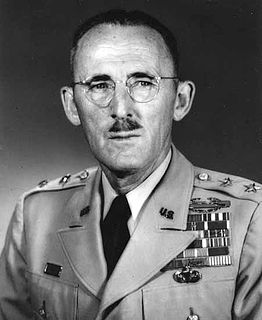
The 278th Armored Cavalry Regiment, previously the 117th Infantry Regiment, is an armored brigade combat team of the Tennessee Army National Guard with headquarters in Knoxville, Tennessee. The unit traces its lineage from the volunteer militias of Eastern Tennessee and has participated in conflicts from the Revolutionary War to the Global War on Terror.

The 95th Infantry Division was an infantry division of the United States Army. Today it exists as the 95th Training Division, a component of the United States Army Reserve headquartered at Fort Sill, Oklahoma.

The 8th Infantry Division, ("Pathfinder") was an infantry division of the United States Army during the 20th century. The division served in World War I, World War II, and Operation Desert Storm. Initially activated in January 1918, the unit did not see combat during World War I and returned to the United States. Activated again on 1 July 1940 as part of the build-up of military forces prior to the United States' entry into World War II, the division saw extensive action in the European Theatre of Operations. Following World War II, the division was moved to West Germany, where it remained stationed at the Rose Barracks in Bad Kreuznach until it was inactivated on 17 January 1992.

The 79th Infantry Division was an infantry formation of the United States Army Reserve in World Wars I and II.

The 83rd Infantry Division ("Thunderbolt") was a formation of the United States Army in World War I and World War II.

The 371st Infantry Regiment was a segregated African American regiment, nominally a part of the 93rd Division, that served in World War I under French Army command, and also in World War II in the Italian Campaign as part of the 92nd Infantry Division (Colored). In both wars the unit had primarily African American enlisted men and white officers.
The 513th Parachute Infantry Regiment was an airborne infantry regiment of the United States Army, raised during World War II. The 513th formed part of the 17th Airborne Division and participated in the European Campaign, fighting in the latter stages of the Battle of the Bulge in January 1945 and parachuted into Germany in Operation Varsity in March, in the largest airborne drop of the war. The regiment returned to the United States in September 1945 where it was inactivated.

Major General Charles Draper William Canham was the commander of the 29th Infantry Division's 116th Infantry Regiment, which landed on Omaha Beach in Normandy, France on D-Day, June 6, 1944.

Sainte-Marie-du-Mont is a commune in the Manche department and in the region of Normandy in north-western France. The commune has 740 inhabitants.
The Gold Medal of Military Valour is an Italian medal established on 21 May 1793 by King Victor Amadeus III of Sardinia "....per bassi ufficiali e soldati che avevano fatto azioni di segnalato valore in guerra".
John Joseph McVeigh was a United States Army soldier and a recipient of the United States military's highest decoration—the Medal of Honor—for his actions during the Battle for Brest in World War II. He was a 1939 graduate of Northeast Catholic High School for boys.
Sherwood Henry Hallman was a United States Army soldier and a recipient of the United States military's highest decoration—the Medal of Honor—for his actions in World War II.

Ernest Childers was a United States Army officer and a recipient of the United States military's highest decoration, the Medal of Honor, for his valorous actions in World War II.

The 2nd Battalion, 127th Infantry Regiment traces its origins to the 4th Infantry Battalion, Wisconsin National Guard.

The 116th Infantry Regiment is an infantry regiment in the Virginia Army National Guard.

The 109th Infantry Regiment is an infantry regiment of the United States Army. Its legacy unit, 1st Battalion, 109th Infantry, is part of the 55th Heavy Brigade Combat Team, a unit of the 28th Infantry Division.
Ernest Veuve, born George Ernest Veuve, was a Swiss-born soldier in the U.S. Army who fought during the American Civil War and the Indian Wars as a member of the 16th U.S. Infantry, 3rd U.S. Infantry and 4th U.S. Cavalry. He was cited for bravery while battling the Kiowa and Comanche in the Staked Plains in November 1874, and fought an Indian in hand-to-hand combat for which he received the Medal of Honor.
The 142nd Infantry Regiment is an infantry regiment in the U.S. Army National Guard. 2nd Battalion, 142nd Infantry carries the regiment's legacy as a unit of the 56th Infantry Brigade Combat Team, 36th Infantry Division. Eleven of its members have been decorated with the United States highest award for bravery, the Medal of Honor.
The 42nd Rifle Division was a unit of the Red Army during the Great Patriotic War. The division, first formed in 1940, was nearly destroyed in the opening days of the Operation Barbarossa defending the Brest Fortress. Disbanded in late December 1941 and immediately reformed in the Volga Military District. The division then served on the front until disbanded at the end of the war.
















